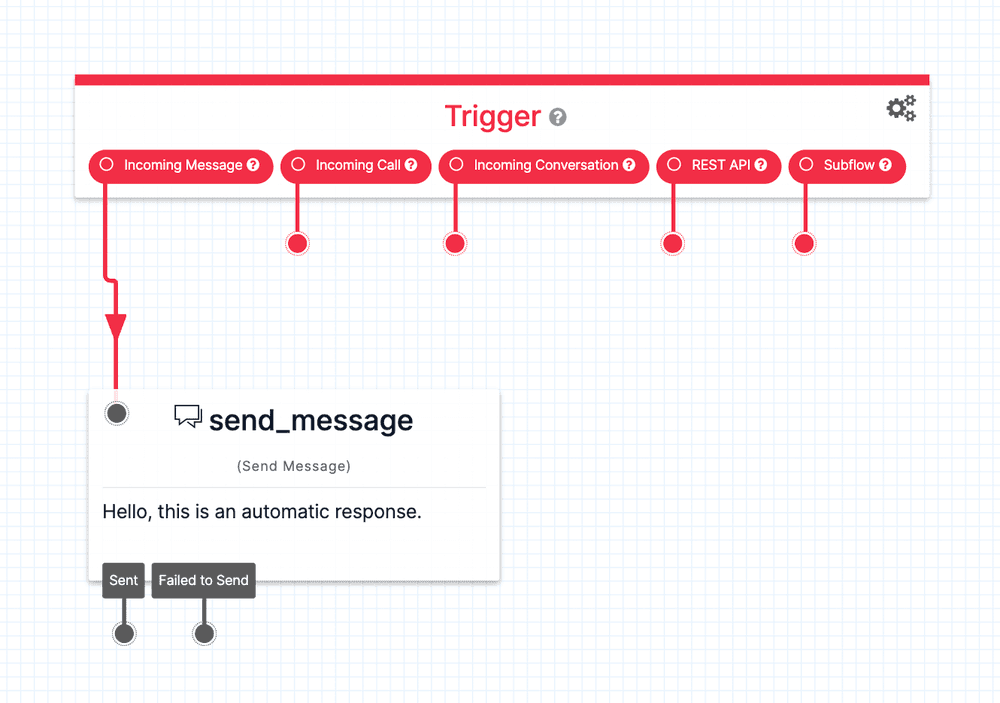No-code SMS quickstart with Twilio Studio
With a few drag-and-drop actions, you can build an application that sends and receives SMS messages.
In this quickstart, you'll build a no-code application to send and receive text messages with Twilio Programmable Messaging. This quickstart uses Twilio Studio, the Twilio low-code application builder, and the Twilio Virtual Phone.
For a developer quickstart that uses programming languages and the REST API, see the SMS developer quickstart.
- Sign up for Twilio. When prompted to select a plan, click Continue with trial.
- On the landing page, click Get phone number.
A Flow is a visual representation of your application, similar to the flowchart you might draw when planning its logic.
To create a Flow, follow these steps:
-
Open the Studio Flows page in the Twilio Console.
-
Click Create new Flow.
If you created a Flow before, click the + icon under the Flows heading.
-
Give your new Flow a name, then click Next. A list of templates you can use displays.
-
Select Start from scratch, then click Next.
After you create a new Flow, Studio displays the following elements:
- Canvas: The space where you build your application.
- Trigger Widget: The Trigger Widget tells Studio when to start, or "trigger," your Flow. To learn more, see Trigger Widget.
- Widget Library: The Widget Library, on the right side of the Canvas, contains all the available Widgets. Widgets are the building blocks of a Studio Flow and perform the functions that make up your application.
To create a system that automatically responds to an incoming message with the Send Message Widget, follow these steps:
-
From the Widget Library on the right, drag the Send Message widget onto the Canvas and place it under the Trigger widget.
-
Click the red dot underneath Incoming Message on the Trigger Widget and drag it to the Send Message Widget to connect them.
Studio now triggers the Flow when it receives a message and then executes the Send Message widget.
-
Configure the Send Message Widget.
With the Widget selected, the Widget Library displays the settings for the Widget:
-
Enter a name in Widget Name. The name must start with a letter and can't contain spaces; use underscores (
_) to separate words. -
Enter a message into the Message Body field. This is the message a user receives when they text your Twilio number.
You can also add a JPG, PNG, or GIF to the message by entering the URL of the media into the Media URL field.
-
Click Save.
Your Flow should resemble this:

-
-
Click Publish to publish your Flow.
Publish your Flow whenever you make changes to make them live.
To tell your Twilio phone number to use your Flow when it receives a text message, follow these steps:
- Open the Active Numbers page in the Twilio Console.
- Click your Twilio phone number.
- In Messaging configuration, under A message comes in, choose Studio Flow, and then select your Flow from Select a Flow.
- Click Save configuration to save your changes.
To test your application, complete the following steps:
-
Open the Send an SMS page in the Twilio Console.
-
On the Send to Virtual Phone tab, select the number that Twilio gave you from the Phone number list.
-
Click Virtual Phone. Messages you send with your application display on the Virtual Phone.
-
Send an SMS to your Twilio phone number:
- Enter a message in the Click here to reply field at the bottom of the Twilio Virtual Phone.
- Click the send icon.
Your application processes the request, and you get the response back as an SMS on the Twilio Virtual Phone.
After you've built your first no-code SMS application, explore these resources:
-
Learn about toll-free verification and Application-to-Person (A2P) 10-Digit Long Code (10DLC) registration. Regulations require:
- Toll-free verification to send SMS messages from toll-free numbers to mobile phones in the US and Canada.
- A2P 10DLC registration to send SMS messages from local numbers to mobile phones in the US.
-
Learn more Twilio Studio basics with Get Started with Twilio Studio.
-
Build more applications with Twilio Studio:
- To create a two-way conversation with your users, use the Send & Wait For Reply widget. See the Build a chatbot with Twilio Studio and Conduct an SMS survey with Twilio Studio tutorials to see the Send & Wait For Reply widget in action.
- Send Appointment Reminders with Twilio Studio.